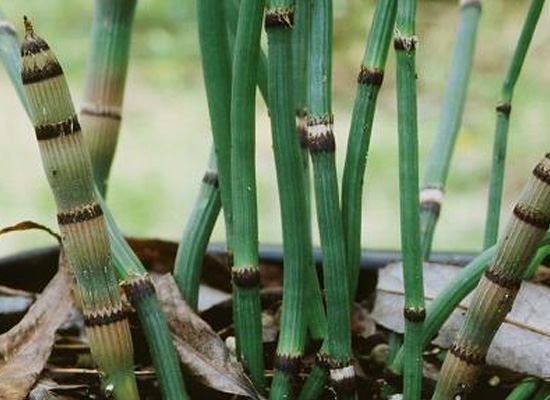Horsetail herb, also known as scouring rush and Mu Zei, is a less commonly used Chinese herb that first found in Jia You Ben Cao (Materia Medica of Jia You Reign). But that does not necessarily imply that it is with a low medicinal value. On the contrary, it has many medicinal uses and the main one is to treat people with eye problems. So, what is horsetail herb used for today? In fact, now horsetail is also used for hair growth, high blood pressure, plane warts and pimple, Acute Conjunctivitis, acute dacryocystitis, Trachoma, colds, cough, Psoriasis, blood in the stool, bleeding hemorrhoids, and so on. When used properly, it can be very effective and will bring instant relief for the sufferers.
Medicinally it refers to the dried above ground part of Hippochaete hyemalis (L.) Bruhin. (or Equisetum hyemale. L.) This is a member in the family Equisetaceae. And other names of horsetail plant include scouring rush, Shave Grass, Herba Equiseti Hiemalis, rough horsetail, Horse Tail, Horsetail Grass, and so on. It is generally collected in summer and autumn. Before the use, it needs to remove impurities and dry in the sun or in the shade. And it can be used in the forms of horsetail supplement, extract, tea, powder, and pills.
HORSETAIL HERB BENEFITS
The Horsetails belong to the only surviving genus of Equisetum. More than that, its family Equisetaceae, its order Equisetales, and its classis Sphenopsida are all single respectively. It is one of the oldest plants on earth. Today the horsetail grass found in corn fields and wetlands in many places of the world is, actually, the dwarf species of huge fossil plants in Carboniferous era. In addition to its medicinal uses, it can be very helpful in everyday life too. Here are some proven tips.
When spring comes, many of the elderly will suffer from eye disorders, such as red eyes, photophobia, burning sensation, increased mucus, too much eye discharge, etc. And the above-mentioned symptoms are often caused by a virus, by a bacterial infection, or by allergies. Traditional Chinese medicine calls it "eyes of fire" and believes that it is associated with wind-heat infection, which is easily triggered in spring due to the growth and development of yang Qi. In this case, drinking horsetail tea is one of the simplest but effective options.

Horsetail Herb
It can be used to make an amazing homemade toner. To make your own secret horsetail-based formula, you need to go through a few steps. To start with, chop the stems that don't bloom yet and put them into a pot; next, add 2 pints of water and 1 tablespoon honey, cover and simmer for about 20 minutes; in addition, add 1 tablespoon of witch hazel juice after cooling and filtering; finally, mix them thoroughly. That's it. This toner is good at shrinking enlarged pores on face and neck.
SAMPLE HERB HORSETAIL HERBAL REMEDIES
The Chinese Materia Medica says that horsetail is bitter and sweet in flavor and neutral and non-toxic in nature. It goes to meridians of lung, liver, and gall bladder. Prime functions are dispersing wind to clear heat, cooling blood to stop bleeding, and removing nebula to improve eyesight. Major horsetail herb use and indications include wind-heat type of hot eyes, nebula, watery eyes caused by wind, hemorrhoidal hemorrhage, bloody diarrhea, prolonged menstrual period, and rectocele. Recommended dosage is from 3 to 10 grams in decoction, pills, and powder.
1. Mu Zei San from Ren Zhai Zhi Zhi Fang Lun (Renzhai's Comprehensive Prescriptions). It is combined with Mu Man Tou (creeping fig), Zhi Ke (Fructus Aurantii), Huai Jiao (Sophora fruit), Fu Ling (Poria), and Jing Jie (Schizonepeta) to treat hemorrhoidal hemorrhage.
2. Lei Shi Mu Zei San. It is formulated with Xiang Fu Zi (Cyperus rotundus rhizome) and Pu Xiao (Glauber's salt) to cure profuse uterine bleeding. If accompanied with pain under the navel, add Ru Xiang (Frankincense), Mo Yao (Myrrh), and Dang Gui (Dong Quai).
3. Mu Zei San from Zheng Zhi Zhun Sheng (The Level-line of Patterns and Treatment). It is matched with Chan Tui (Cicada Molting), Gu Jing Cao (Eriocaulon, Pipewort), Gan Cao (Licorice Root), Cang Zhu (Atractylodes), She Tui (Periostracum Serpentis), and Huang Qin (Scutellaria Baicalensis) to heal bloodshot eyes and slight corneal opacity.

![Diseases, Symptoms, tcm, [tcmwindow.com]](/uploadFile/adImg/2015/11/11/f5cbfcc0-4df5-4646-9b9a-f316651a0199.jpg)





